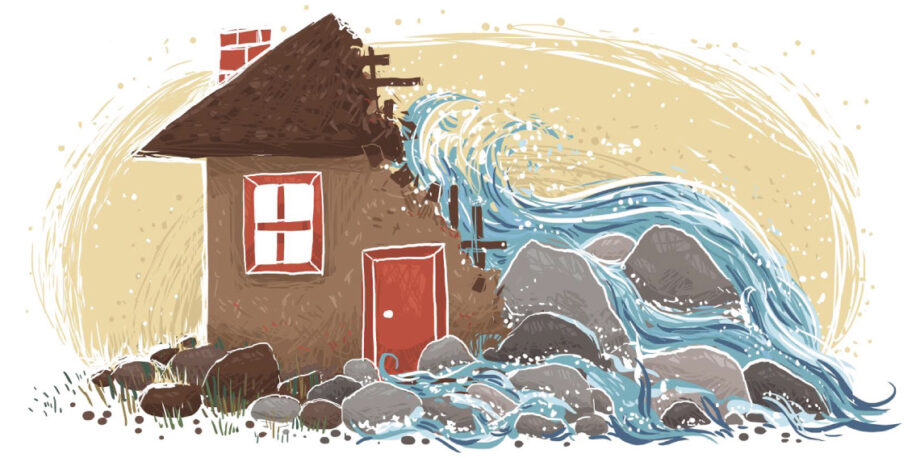January 28, 2014 — While less than 10 percent of U.S. land area is coastline (excluding Alaska), “123.3 million people … or 39 percent of the nation’s population lived in” shoreline counties in 2010, according to the federal government. Put differently, our coasts, “substantially more crowded than the U.S. as a whole,” have a population density more than six times that of inland counties.
So our coastlines are well populated if not downright packed, and that spells trouble [pdf] whenever big storms come a-knockin’ — the kind of trouble that often lingers long after blue skies return. Now, add to that climate change with increasing storm intensity and sea levels projected to rise by about 3 feet by the century’s end, and you’ve got yourself a real problem without an obvious solution. Do you rebuild after every storm and flood, hoping you can fortify the new infrastructure to survive the next one? Or do you give up and retreat to higher ground?
Such questions are especially palpable for New Yorkers and New Jerseyans who live (or lived) along the destructive path of Superstorm Sandy, a mammoth storm that barreled up the Atlantic coastline in October 2012. Communities decimated by Sandy must now decide what to do. Some say “rebuild,” and the federal government has put substantial funds into such efforts post-Sandy. Others, like New York governor Andrew Cuomo, argue that certain coastal communities should recognize the inevitable and retreat to higher ground. Federal dollars [pdf] are also substantially funding this choice.
“Everybody had just finished their renovation from Irene … and then, a month or two later, this storm comes and that was the knockout punch.” — Joe Tirone
So which response makes the most sense? It’s a question of vital importance and not just for New Yorkers and New Jerseyans. How these communities respond to Sandy will be instructive for the myriad of other communities that must decide how to respond to the new normal coming courtesy of climate change. Interestingly, both approaches are being pursued. Let’s take a look.
A Case for Retreat
Hurricane Sandy, according to Gov. Cuomo, damaged “[a]s many as 300,000 homes across the state … and approximately two-thirds of all properties flooded by Sandy were not covered by flood insurance.”
In the aftermath of such devastation, last year the governor effectively offered New York property owners whose houses had been devastated by Hurricane Sandy a deal: sell their property to the state for its pre-Sandy value, and the state would turn that land into greenspace intended to provide protection to inland communities from future storms. For a number of New Yorkers, including 319 Staten Islanders in the Fox Beach neighborhood of Oakwood Beach, that was an offer they couldn’t refuse — as of this writing, according to Joe Tirone, a Staten Island real estate broker and Fox Beach property owner who helped organize the Fox Beach buyouts, 310 homeowners have filed buyout applications, 258 have received offers from the state, and 100 have completed their sales.* And the demolitions have begun.
For Tirone, Sandy changed everything.
It “knocked everybody back on their heels,” Tirone says. “Everybody had just finished their renovation from Irene … and then, a month or two later, this storm comes and that was the knockout punch. The one where they just said, ‘I can’t do it anymore.’”

Before and after photos of Joe Tirone’s house in Oakwood Beach on Staten Island, New York. Tirone’s house was sold to the state and demolished as part of a buyout plan that will turn his neighborhood into greenspace that the state hopes will serve as protection from future storms. Photos by Joe Tirone
The 11-foot flood line on Tirone’s one-story, one-family rental property would have meant a complete gut renovation.
“There was nothing that was really salvageable, and if I were to rebuild it, I probably would have ripped the siding off as well because of mold,” he says. “In case the buyout didn’t work, I was ready to fix it up again and rent it for awhile and then sell it eventually. But, thank God, I didn’t have to do that.”
While prepared for the worst, Tirone took action when he heard about the buyout plan, attending meetings, researching the program and organizing his neighbors.
As it turned out, Fox Beach was a good candidate for the buyout and greenspace restoration. It’s located in the middle of the Bluebelt stormwater management system, which includes “15 watersheds clustered at the southern end of the Island, plus the Richmond Creek watershed” that convey, store and filter stormwater. Through this project, the state will be able to restore the area to its natural wetland status improving the ecosystem services provided by the Bluebelt.
But while Tirone and his neighbors seek higher ground, with assistance from the feds and the state, New York City is planning to hunker down.
Bloomberg on the Waterfront: “We Must Protect It, Not Retreat From It”
When it comes to solutions to problems posed by Sandy and the like, former New York City mayor Michael Bloomberg had a lot of them. As well he should: Increasing storm intensity and sea-level rise pose enormous challenges to the city. “We expect that by mid-century up to one-quarter of all of New York City’s land area, where 800,000 residents live today, will be in the floodplain,” Bloomberg said last June. “If we do nothing, more than 40 miles of our waterfront could see flooding on a regular basis, just during normal high tides.”
A full-bore retreat would mean abandoning such historic sites as Ground Zero — a scenario that any New Yorker, let alone a mayor, would find hard to stomach.
The former mayor has spoken in favor of limited retreat as well as the development of natural buffer zones. And he has called for expanding the Bluebelts, which have been “incredibly successful at absorbing floodwaters in Staten Island,” he said. But with 25 percent of NYC’s land area threatened by flooding, it’s not surprising the Bloomberg administration’s main strategy for a future sustainable city is more about rebuilding and protecting rather than retreating.
Consider, for instance, that a full-bore retreat would mean abandoning such historic sites as Ground Zero — a scenario that any New Yorker, let alone a mayor, would find hard to stomach.
It Ain’t Cheap
Bloomberg’s plans are detailed in “A Stronger, More Resilient New York” [pdf], an in-depth report that includes 250 concrete recommendations to better protect the city from storms and other impacts expected from climate change.** The report lays out a strategy for holding onto most of the city’s coastal communities through “a combination of permanent elements and flexible flood protection systems” (i.e., “a system of strategically placed floodwalls, levees and other features [that] would provide a strong line of defense against flooding”). Bill de Blasio, New York’s new mayor, has indicated he is on board with the path Bloomberg blazed in this area — a path carrying a price tag of almost $20 billion.
I have to say, the 400-plus-page report (along with the environmental initiatives outlined in Bloomberg’s PlaNYC and the projections by the NYPCC [pdf]) reflects a very careful, thoughtful and sophisticated assessment of the threats to New York City and how to protect it and its residents from those threats.
The question in my mind is — assuming that all the flood-protection infrastructure gets built — what happens if things turn out to be much worse than what is being projected? What if the flood barriers fail and the city is inundated by another storm? (These types of failures do happen — think the New Orleans flood during Katrina.) Does the city rebuild yet again (as New Orleans is doing), and construct even greater protective barriers? And who pays? (See this recent New York Times article on the costliness of putting off dealing with climate change.) And what happens to the people in harm’s way? I don’t recall seeing those issues addressed in the mayor’s plan.
I hate to think of this, but it could be that decades from now people will look back on the rebuild decisions made by New York City, New Orleans and the like as prime examples of denial. On the other hand, smart rebuilding could turn out to be visionary and innovative steps into a globally warming future. Let’s hope it’s the latter. ![]()
Editor’s note: The views expressed here are those of the author and not necessarily of Ensia. We present them to further discussion around important topics. We encourage you to respond with a comment below, following our commenting guidelines, which can be found here. In addition, you might consider submitting a Voices piece of your own. See Ensia’s “Contact” page for submission guidelines.
End Notes
* As of this writing, according to Joe Tirone, who helped organize the buyouts, there was one holdout in Fox Beach and several had not accepted the state’s offer for their home. There were 184 homes in the first phase of the area’s buyout; a second phase added another 135 Oakwood Beach homes to the plan.
** The report was informed in part by the work [pdf] of the New York City Panel on Climate Change that Bloomberg empaneled “to study the effects of the changing climate on a metropolitan region” and that “developed New York-specific climate projections.”
Ensia shares solutions-focused stories free of charge through our online magazine and partner media. That means audiences around the world have ready access to stories that can — and do — help them shape a better future. If you value our work, please show your support today.
Yes, I'll support Ensia!

They do not. Think North Sea, Providence RI, the Thames.
An outer storm barrier would also protect NJ but would cost 10's of billions. Inner barriers would be $10 billion for the three entry points and would protect Manhattan only.
Storm barriers are designed to deflect the bulk of the surge, not the whole surge and are routinely overtopped by waves and sometimes the surge itself. An inch per decade sea level rise will make no difference in the design or operation of such barriers for their lifetime.
The first step is to split water using sun light to get HYDROGEN, THE CLEAN FUEL. Over a year ago scientists from Rochester IT had paper(Sci. Vol. 338,, pg. 1341, 2012) detailing a catalyst for effective H2 generation from water. But it seems that most environmental groups are unaware of this clean fuel as they rant can'ts against fossil fuels and N-power.
We could also be using pyrolysis on our massive ever mounting biowaste messes, including separated sewage solids, that may bury our kids' futures. Pyrolysis generates a chemical mix that can be refined and used to make drugs, detergents, etc. that now get made from oil. The charcoal that gets formed in pyrolysis can be used for a soil amendment as it has some plant nutrients.
Making charcoal to use this way results in a CO2 removal process that could slowly reduce CO2 levels in our biosphere. This operation would let us use Nature to help reduce CC/GW.
We also ought to reestablish the CCC program of Roosevelt and get dead and dying trees harvested to be sent to pyrolysis plants. This program is needed in Pacific NW as millions of several types of evergreen trees are dying due to bugs. The CCC people would also be planting new trees that are not susceptible to the bugs. The best way to be lowering CO2 levels to curb CC/GW is by planting trees as we can eventually gets a needed biochemical supply line developed free of oil that will run out some day.
The charcoal gotten from trees can be used to smelt iron ore with several benefits for humans. The present smelting of iron ore uses soft coal that gets coked, a process mainly responsible for rising levels of mercury in our biosphere. Also the mining of coal has scarred much land in several states, where leaching of mine wastes is badly damaging stream ecology(See Sci. V. 343, p. 592-5, 2014).
I urge ENSIA to start calling for the program outlined above. J.A. Singmaster, III, Ph.D., UCDavis, 76
Here's Russia's barrier: http://en.wikipedia.org/wiki/Saint_Petersburg_Dam
There's not much to fail and even if one lock got stuck in the open position during a storm it would still be a huge improvement over the present situation.